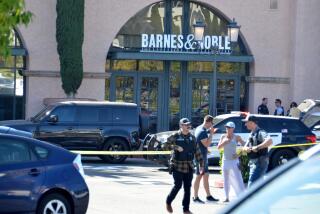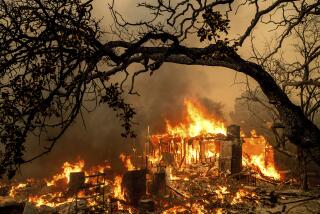C. Almaraz, 48; Chicano Artist of Urban Scene
Carlos Almaraz, locally acclaimed Chicano artist praised for his murals and drawings of urban fantasies over the last two decades, has died of complications of AIDS, his lawyer announced Wednesday.
Attorney Amy Nieman said Almaraz, 48, died in his sleep at 11:30 p.m. Monday at Sherman Oaks Community Hospital.
Almaraz, who preferred to be known as a Chicano rather than Hispanic or Latino, began his career as one of “Los Four,” a quartet of friends from UC Irvine who painted with spray cans, combining the popular folk art of the East Los Angeles barrio with what they learned about art in college. His compatriots were Robert de la Rocha, Gilbert Lujan and Frank Romero.
At the time, Almaraz was known as “Charles” rather than the Latino “Carlos,” but was the most openly political of the four and gained a reputation for his angry political iconography, campaigning for Latino grape workers’ rights, and for fighting for the dignity of fellow Latinos.
At the time of a 1974 exhibit of the group’s work at Los Angeles County Museum of Art, Almaraz said he opposed quality or permanency in art and did not expect his--done in spray or house paints--to endure.
“Using quality as a basis for art benefits museums, collectors and investors, not artists,” he told The Times. “I now have $3 in my pocket borrowed from my grandmother. Too many artists arrive broke at their own opening.”
Questioned about his anti-Establishment, anti-material views, he said simply: “I love people more than art.”
Almaraz became more materially successful, however, perhaps in spite of himself, selling his works through galleries such as the Jan Turner Gallery.
He regarded himself as less militant in recent years, but retained his wariness of institutions. During a Latino art exhibit at the county Museum of Art earlier this year, the first since that of “Los Four” in 1974, he told a Times interviewer:
“They’re not interested in Hispanic art. It’s like the song, just ‘Another op’nin’ another show.’ This is supposed to appease the peasants. People will be quiet for another 15 years.”
In 1981, Almaraz was one of nine Latino artists commissioned for the Los Angeles Bicentennial to paint for viewers at the Craft and Folk Art Museum. He depicted a mural of a mural on the side of the Hotel Figueroa with a blazing pile of junked cars leaning against a tilting city hall.
Examining an exhibition of 30 Almaraz drawings in brilliant color at the Adrienne Simard Gallery in 1981, Times art critic Suzanne Muchnic observed that “his art has grown better over the years. . . . Tentative color fields and primitive drawing have meshed and developed into a personal style that is intensely expressive and self-assured.
“Almaraz delivers messages of doom without making them seem immediately threatening,” she said. “He accomplishes that by setting a dreamlike atmosphere and by using ingratiating color. Ghostlike figures arising from mad dogs, bloodless car crashes and cancer-causing TV sets are observed as if they belong to someone else’s universe or to a nightmare that is, after all, only a dream.”
Almaraz is survived by his wife, Elsa Flores Almaraz; a 6-year-old daughter, Maya; his parents, Rudolph and Rose Almaraz, and a brother, Rudy Almaraz.
Nieman said a private memorial service is planned. She said the family asks that donations be made in the artist’s honor to Milagros AIDS Project, 741 S. Atlantic Blvd., Los Angeles, Calif., 90022.
More to Read
Start your day right
Sign up for Essential California for news, features and recommendations from the L.A. Times and beyond in your inbox six days a week.
You may occasionally receive promotional content from the Los Angeles Times.






